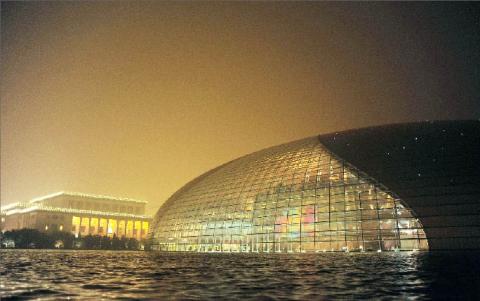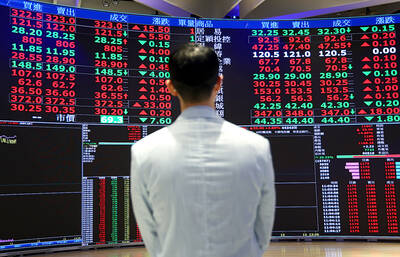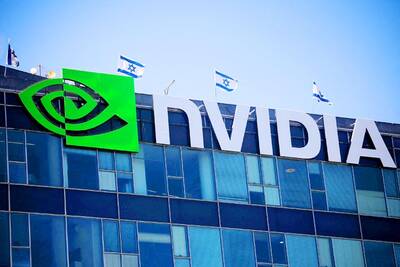China and other rapidly developing Asian nations are attracting cutting-edge international architects as their increasingly futuristic skylines offer the chance to push design boundaries.
French architect Paul Andreu was handed what he calls a once-in-a-lifetime opportunity when Chinese authorities picked him to design an ultra-modern opera house in the center of Beijing.
“I’m grateful towards China,” said Andreu, whose 300 million euro (US$430 million) opera house — a rounded titanium and glass structure — rises from a man-made moat next to the Forbidden City and Tiananmen Square.

Photo: AFP
“That was an opportunity that you only get once in your life, if at all,” said the award-winning architect, who is currently working on two other projects in China. “China is building a huge amount, so opportunities are huge. But China also has a lot of ambition. For years, they didn’t do much, and I’m sure they had the feeling they were lagging behind.”
Now, the Asian powerhouse — whose breakneck growth over the past 30 years has transformed it into the world’s second-largest economy and fueled a colossal construction boom — is making up for lost time.
The 90,000-seat “Bird’s Nest” stadium, which became the centerpiece of the 2008 Olympics with its threads of interlocking steel beams, is probably the best known of innovative structures that dot China’s skyline.
Beijing’s soaring CCTV (中國中央電視台) tower — described as one of the most daring pieces of architecture ever attempted — and Shanghai’s 101-story World Finance Center are also high-profile examples of cutting-edge design.
Andreu is designing a colorful archaeological museum in the northern city of Taiyuan and Zaha Hadid — the first woman to receive the Pritzker Architecture Prize — has just finished a 1,800-seat opera house in southern Guangzhou.
Renowned British architect Norman Foster, who designed the much-acclaimed Terminal 3 at Beijing’s international airport, is also building the headquarters for CITIC Bank (中信銀行) in the eastern city of Hangzhou.
Foreign firms are not the only ones taking advantage of opportunities in China. Homegrown architects are also making their mark at home and abroad.
Ma Qingyun (馬清運), whose firm MADA s.p.a.m. has countless projects across China, was named one of the world’s most influential designers by Businessweek last year, along with Hadid.
Earlier this month, the French Architecture Academy gave its gold medal — a top award — to Wang Shu (王澍), who focuses on sustainable design.
“The architectural arena is changing — it’s leaning towards more intellectual and creative freedom,” Andreu said.
Michael Tunkey, the Shanghai-based partner at international firm Cannon Design, said other countries in Asia were also proving a boon for architects.
“The fact that Chinese salaries have been rocketing over the last couple of years has generated larger opportunities for places like Vietnam and Thailand,” he said.
Nguyen Chi Tam, design director at HighEnd Architecture in Hanoi, said there had been “more and more” architect offices opening in Vietnam in recent years — both mid-sized firms and global giants.
“With a downturn in Europe, foreign firms have turned to Asia, including Vietnam,” he said.
Tam’s office is collaborating with famed Italian architect Renzo Piano on a project for a new opera house in Hanoi, while the New York-based Carlos Zapata recently worked on the 68-story Bitexco Financial Tower in Ho Chi Minh City.
However, as in Beijing where much of the old town has been torn down, Hanoi is having trouble preserving its heritage despite a law on conservation enacted in 2001.
“On paper there are still more than 1,000 French villas in Hanoi, but in my opinion, there are really only a few hundred that have kept their original colonial style,” said Hoang Dao Kinh, a Hanoi-based architect.
Preserving the old while embracing the new is a challenge that other Asian nations face too. Singapore, for one, has been relatively successful.
To date, more than 7,000 old buildings have been preserved by the city-state’s national planning authority, adapted into restaurants, offices or homes.
However, it is also the home of architectural feats such as the US$5.5 billion Marina Bay Sands resort that boasts three 55-story hotel towers linked by a huge sky park 200m above the sea.
Sustainable engineering is also starting to take hold in Asia. Ciputra World, a business and entertainment complex in Indonesia’s capital Jakarta, is one such example.
The 3 trillion rupiah (US$350 million) project aims to reduce energy usage by at least 20 percent compared to a regular building, with double-glazed windows and a sophisticated indoor air system.
Back in China, the Pearl River Tower in Guangzhou, due to be completed this year, has been dubbed “the world’s greenest skyscraper.”
Its structure directs winds to openings where they push turbines that generate the building’s energy, according to architecture firm SOM, which is working on the project.
Tunkey said China is still lagging far behind the US and Europe in terms of clean technology buildings.
“But if it decides to get in front of the curve, it has got the potential to ramp it up in a way that no other country really can,” he said.
Ma, meanwhile, said China faced a key challenge in the next few years in finding its own architectural path “that corresponds to Chinese people’s aesthetic habits and experiences.”

Micron Memory Taiwan Co (台灣美光), a subsidiary of US memorychip maker Micron Technology Inc, has been granted a NT$4.7 billion (US$149.5 million) subsidy under the Ministry of Economic Affairs A+ Corporate Innovation and R&D Enhancement program, the ministry said yesterday. The US memorychip maker’s program aims to back the development of high-performance and high-bandwidth memory chips with a total budget of NT$11.75 billion, the ministry said. Aside from the government funding, Micron is to inject the remaining investment of NT$7.06 billion as the company applied to participate the government’s Global Innovation Partnership Program to deepen technology cooperation, a ministry official told the

Taiwan Semiconductor Manufacturing Co (TSMC, 台積電), the world’s leading advanced chipmaker, officially began volume production of its 2-nanometer chips in the fourth quarter of this year, according to a recent update on the company’s Web site. The low-key announcement confirms that TSMC, the go-to chipmaker for artificial intelligence (AI) hardware providers Nvidia Corp and iPhone maker Apple Inc, met its original roadmap for the next-generation technology. Production is currently centered at Fab 22 in Kaohsiung, utilizing the company’s first-generation nanosheet transistor technology. The new architecture achieves “full-node strides in performance and power consumption,” TSMC said. The company described the 2nm process as

Shares in Taiwan closed at a new high yesterday, the first trading day of the new year, as contract chipmaker Taiwan Semiconductor Manufacturing Co (TSMC, 台積電) continued to break records amid an artificial intelligence (AI) boom, dealers said. The TAIEX closed up 386.21 points, or 1.33 percent, at 29,349.81, with turnover totaling NT$648.844 billion (US$20.65 billion). “Judging from a stronger Taiwan dollar against the US dollar, I think foreign institutional investors returned from the holidays and brought funds into the local market,” Concord Securities Co (康和證券) analyst Kerry Huang (黃志祺) said. “Foreign investors just rebuilt their positions with TSMC as their top target,

H200 CHIPS: A source said that Nvidia has asked the Taiwanese company to begin production of additional chips and work is expected to start in the second quarter Nvidia Corp is scrambling to meet demand for its H200 artificial intelligence (AI) chips from Chinese technology companies and has approached contract manufacturer Taiwan Semiconductor Manufacturing Co (TSMC, 台積電) to ramp up production, sources said. Chinese technology companies have placed orders for more than 2 million H200 chips for this year, while Nvidia holds just 700,000 units in stock, two of the people said. The exact additional volume Nvidia intends to order from TSMC remains unclear, they said. A third source said that Nvidia has asked TSMC to begin production of the additional chips and work is expected to start in the second